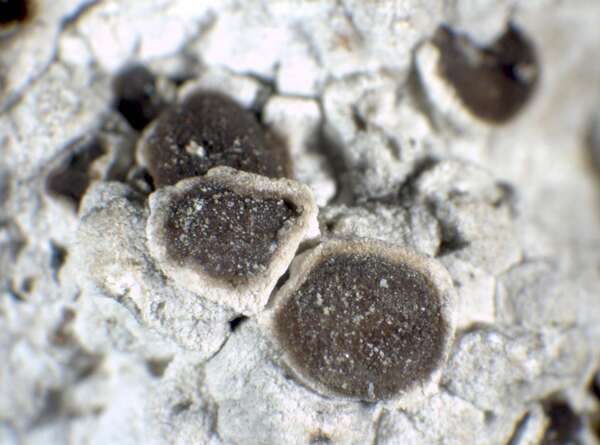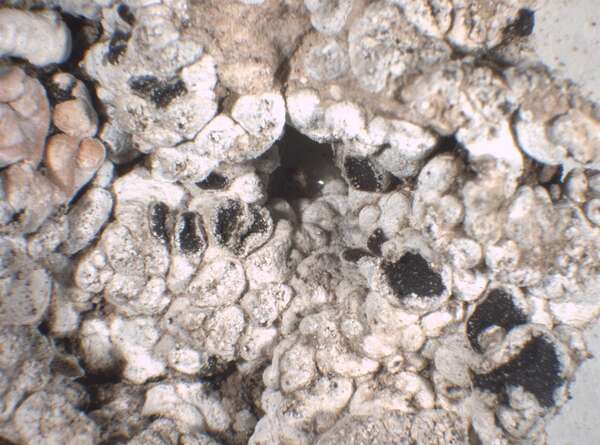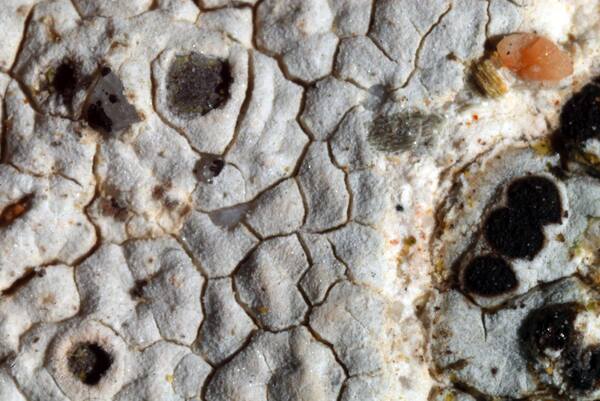Acarospora nodulosa var. reagens (Zahlbr.) Clauzade & Cl. Roux
Bull. Mus. Hist. Nat. Marseille, 41: 61, 1981. Basionym: Acarospora reagens Zahlbr. - Beih. Bot. Centralblatt, 8: 162, 1902.
Synonyms: Acarospora granatensis Samp.?; Acarospora zahlbruckneri Samp.
Distribution: N - Emil (Nimis & al. 1996, Fariselli & al. 2020). S - Cal (Nimis & Puntillo 2003, Puntillo 2011).
Description: Thallus areolate-subsquamulose, densely chalky white-pruinose, areolate, forming up to 5 cm wide patches. Areoles (2-)3-5(-6) mm wide, 0.2-2 mm thick, rounded, mostly convex, slightly lobed; lower surface attached by a few rhizines. Cortex densely filled with crystals visible under polarized light; algal layer continuous; medulla white, filled with crystals. Apothecia lecanorine, 1-2(-3) mm across, round, at first immersed, later sessile, with a flat to slightly convex, dark brown to almost black, epruinose disc, and a thick thalline margin. Epithecium yellowish brown, K-; hymenium colourless, 50-180 μm high; paraphyses coherent, simple to sparingly branched in upper part, 1.5-2.5 μm thick at base, the apical cells slightly swollen; hypothecium colourless, 40-85 μm high, K-. Asci c. 100-spored. clavate, with a distinct apical dome, K/I-. Ascospores 1-celled, hyaline, globose or subglobose, 3-6 x 3-7 μm. Photobiont chlorococcoid. Spot tests: K+ yellow turning red (acicular red crystals), C-, KC-, P+ orange-yellow (reactions more evident in the medulla). Chemistry: thallus with norstictic acid.Note: a xeric subtropical lichen found on gypsum in exposed situations below the montane belt; to be looked for in other gypsum outcrops of Southern Italy (e.g. in Sicily). The type material is from western North America.
Growth form: Crustose
Substrata: rocks, soil, terricolous mosses, and plant debris
Photobiont: green algae other than Trentepohlia
Reproductive strategy: mainly sexual
Subcontinental: restricted to areas with a dry-subcontinental climate (e.g. dry Alpine valleys, parts of Mediterranean Italy)
paras Diploschistes diacapsis
Commonnes-rarity: (info)
Alpine belt: absent
Subalpine belt: absent
Oromediterranean belt: absent
Montane belt: absent
Submediterranean belt: extremely rare
Padanian area: absent
Humid submediterranean belt: absent
Humid mediterranean belt: absent
Dry mediterranean belt: extremely rare

Predictive model
Herbarium samples


P.L. Nimis; Owner: Department of Life Sciences, University of Trieste
Herbarium: TSB (20442)
2001/12/09


P.L. Nimis; Owner: Department of Life Sciences, University of Trieste
Herbarium: TSB (35701)
2003/01/22
Growth form: Crustose
Substrata: rocks, soil, terricolous mosses, and plant debris
Photobiont: green algae other than Trentepohlia
Reproductive strategy: mainly sexual
Subcontinental: restricted to areas with a dry-subcontinental climate (e.g. dry Alpine valleys, parts of Mediterranean Italy)
paras Diploschistes diacapsis
Commonnes-rarity: (info)
Alpine belt: absent
Subalpine belt: absent
Oromediterranean belt: absent
Montane belt: absent
Submediterranean belt: extremely rare
Padanian area: absent
Humid submediterranean belt: absent
Humid mediterranean belt: absent
Dry mediterranean belt: extremely rare

Predictive model
| Herbarium samples |


P.L. Nimis; Owner: Department of Life Sciences, University of Trieste
Herbarium: TSB (20442)
2001/12/09


 Index Fungorum
Index Fungorum
 GBIF
GBIF



